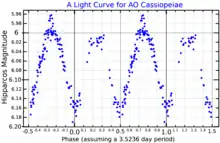 | |
| Observation data Epoch J2000 Equinox J2000 | |
|---|---|
| Constellation | Cassiopeia |
| Right ascension | 00h 17m 43.062s[1] |
| Declination | +51° 25′ 59.12″[1] |
| Apparent magnitude (V) | 6.14[2] (6.07-6.24[3]) |
| Characteristics | |
| Spectral type | O8V((f)) + O9.2II[4] |
| U−B color index | −0.97[2] |
| B−V color index | −0.13[2] |
| Variable type | Eclipsing Variable star[3] |
| Astrometry | |
| Radial velocity (Rv) | −31.10[5] km/s |
| Proper motion (μ) | RA: −3.98 ± 0.35[1] mas/yr Dec.: −1.76 ± 0.29[1] mas/yr |
| Parallax (π) | 1.36 ± 0.44 mas[1] |
| Distance | approx. 2,400 ly (approx. 700 pc) |
| Absolute magnitude (MV) | −[6] |
| Orbit[7] | |
| Period (P) | 3.52348 days |
| Semi-major axis (a) | 28.57 R☉ |
| Eccentricity (e) | 0 |
| Inclination (i) | 65.7° |
| Longitude of the node (Ω) | 3.10° |
| Semi-amplitude (K1) (primary) | 143.7 km/s |
| Semi-amplitude (K2) (secondary) | 230.6 km/s |
| Details[7] | |
| II | |
| Mass | 9.65 M☉ |
| Radius | 9.43 R☉ |
| Luminosity | 115,000[8] L☉ |
| Surface gravity (log g) | 3.45 cgs |
| Temperature | 29,239 K |
| Rotational velocity (v sin i) | 120[8] km/s |
| V | |
| Mass | 15.59 M☉ |
| Radius | 4.61 R☉ |
| Luminosity | 66,000[8] L☉ |
| Surface gravity (log g) | 4.30 cgs |
| Temperature | 33,675 K |
| Rotational velocity (v sin i) | 130[8] km/s |
| Other designations | |
| Database references | |
| SIMBAD | data |
AO Cassiopeiae, also known as Pearce's Star, is a binary system composed of an O8 main sequence star and an O9.2 bright giant that respectively weigh anywhere between 20.30 and 57.75 times and 14.8 and 31.73 times the mass of the Sun.[10]

A light curve for AO Cassiopeiae, plotted from Hipparcos data
The AO Cas system is an eclipsing binary with a period of roughly 3.5 days, with the apparent magnitude ranging between 6.07 and 6.24.[11] Stars of this brightness are generally just visible to the unaided eye in dark skies in semirural locations.[12] The component stars are so close to each other they are ellipsoidal (egg-shaped).[13] AO Cas is considered a contact binary, with both stars at or near their Roche lobes.[3]
References
- 1 2 3 4 5 van Leeuwen, F. (2007). "Validation of the new Hipparcos reduction". Astronomy and Astrophysics. 474 (2): 653–664. arXiv:0708.1752. Bibcode:2007A&A...474..653V. doi:10.1051/0004-6361:20078357. S2CID 18759600.Vizier catalog entry
- 1 2 3 Ducati, J. R. (2002). "VizieR Online Data Catalog: Catalogue of Stellar Photometry in Johnson's 11-color system". CDS/ADC Collection of Electronic Catalogues. 2237. Bibcode:2002yCat.2237....0D.
- 1 2 3 Samus, N. N.; Durlevich, O. V.; et al. (2009). "VizieR Online Data Catalog: General Catalogue of Variable Stars (Samus+ 2007-2013)". VizieR On-line Data Catalog: B/GCVS. Originally Published in: 2009yCat....102025S. 1. Bibcode:2009yCat....102025S.
- ↑ Sota, A.; Maíz Apellániz, J.; Walborn, N. R.; Alfaro, E. J.; Barbá, R. H.; Morrell, N. I.; Gamen, R. C.; Arias, J. I. (2011). "The Galactic O-Star Spectroscopic Survey. I. Classification System and Bright Northern Stars in the Blue-violet at R ~ 2500". The Astrophysical Journal Supplement. 193 (2): 24. arXiv:1101.4002. Bibcode:2011ApJS..193...24S. doi:10.1088/0067-0049/193/2/24. S2CID 119248206.
- ↑ Pourbaix, D.; Tokovinin, A. A.; Batten, A. H.; Fekel, F. C.; Hartkopf, W. I.; Levato, H.; Morrell, N. I.; Torres, G.; Udry, S. (2004). "SB9: The ninth catalogue of spectroscopic binary orbits". Astronomy and Astrophysics. 424 (2): 727–732. arXiv:astro-ph/0406573. Bibcode:2004A&A...424..727P. doi:10.1051/0004-6361:20041213. S2CID 119387088.
- ↑ Conti, Peter S.; Alschuler, William R. (1971). "Spectroscopic Studies of O-Type Stars. I. Classification and Absolute Magnitudes". Astrophysical Journal. 170: 325. Bibcode:1971ApJ...170..325C. doi:10.1086/151218.
- 1 2 Palate, M.; Rauw, G. (2012). "Spectral modelling of circular massive binary systems. Towards an understanding of the Struve-Sahade effect?". Astronomy & Astrophysics. 537: A119. arXiv:1109.1103. Bibcode:2012A&A...537A.119P. doi:10.1051/0004-6361/201117520. S2CID 84840295.
- 1 2 3 4 Bagnuolo, W. G.; Gies, D. R. (1992). "Tomographic Separation of Composite Spectra of O-Type Stars". Complementary Approaches to Double and Multiple Star Research. 32: 140. Bibcode:1992ASPC...32..140B.
- ↑ Struve, O.; Rudkjøbing, M. (1948). "A Note on the Spectrum of HD 698 (j. A. Pearce's Star of Large Mass)". Astrophysical Journal. 108: 537. Bibcode:1948ApJ...108R.537S. doi:10.1086/145098.
- ↑ Hohle, M. M.; Neuhäuser, R.; Schutz, B. F. (April 2010), "Masses and luminosities of O- and B-type stars and red supergiants", Astronomische Nachrichten, 331 (4): 349, arXiv:1003.2335, Bibcode:2010AN....331..349H, doi:10.1002/asna.200911355, S2CID 111387483
- ↑ Watson, Christopher (4 January 2010). "AO Cassiopeiae". AAVSO Website. American Association of Variable Star Observers. Retrieved 15 February 2014.
- ↑ Bortle, John E. (February 2001). "The Bortle Dark-Sky Scale". Sky & Telescope. Sky Publishing Corporation. Retrieved 5 February 2014.
- ↑ Astronomy and Cosmogony. CUP Archive. 1929. pp. 125–. GGKEY:KFJRG3PWW14.
External links
This article is issued from Wikipedia. The text is licensed under Creative Commons - Attribution - Sharealike. Additional terms may apply for the media files.